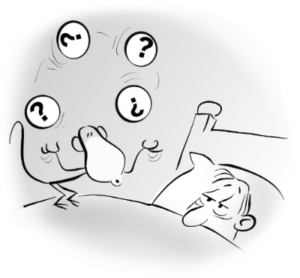Many Americans are experiencing a higher level of worrying since the presidential election. Our country is in midst of a big transition and the stakes are high. We don’t know what will happen and uncertainty is worrisome for many.
As an anxiety disorder therapist, I’ve worked with many people who worry. Can I apply what works with chronic worriers to political anxiety?
Whatever the cause of your worry or level of intensity, the same part of our brains sets worry in motion. The limbic emotional brain perceives threats and alerts us to them. Because it is primitive, instinctual, and totally focused on survival, I call it the monkey mind.
When we experience uncertainty about something we care about, our health care for example, the monkey mind registers this as a threat. The monkey’s mantra is, what you don’t know can kill you. Anxiety is the monkey’s call to action. You’re in danger, do something!
So what do we do? We may try to vent our emotions by demonizing and name calling. We may check our preferred news feeds obsessively, looking for evidence that we are right. We may avoid listening to views not our own, or even avoid interacting with others who have different political beliefs all together. And of course, we worry. We lay awake at night with the what if’s scrolling across our brains.
These reactions to uncertainty don’t stop our worrying and they don’t address perceived threats. Rather than reacting to political uncertainty, how can we respond to it? Working with my clients I’ve developed a terrific protocol to help. I call it the 5 Step Action Plan.
Step 1. Identify the problem clearly. Instead of saying, Everything could fall apart, you might say, I am worried about losing my health care.
Step 2. Brain storm four different actions you can take. For example:
- Educate yourself about policies related to health care.
- Write letters to public officials stating your concern.
- Volunteer at or donate to an organization that supports healthcare for all.
- Move to another country. (Remember, you are brainstorming. Each idea does not have to be realistic.)
Step 3. Evaluate each action. Think of the short and long term consequence of each one.
Step 4. Pick one or more of the actions, and act.
Step 5. Look at the results. What are the positive and negative consequences of the actions you took? Are there other actions to take? Pat yourself on the back for doing something!
When we take responsible action, it helps reduce feeling overwhelmed and helpless. The monkey mind gets the message that, I am aware of the threat and I am handling it, and our anxiety is reduced. It does not mean that the problem is solved, but that we are constructively involved in doing something about it.
If you have taken these steps and are still experiencing unproductive anxiety and worry, stay tuned for my next newsletter where I will introduce a powerful tool of relaxing into discomfort. Until then remember, when the monkey calls, respond, don’t react.



Recent Comments